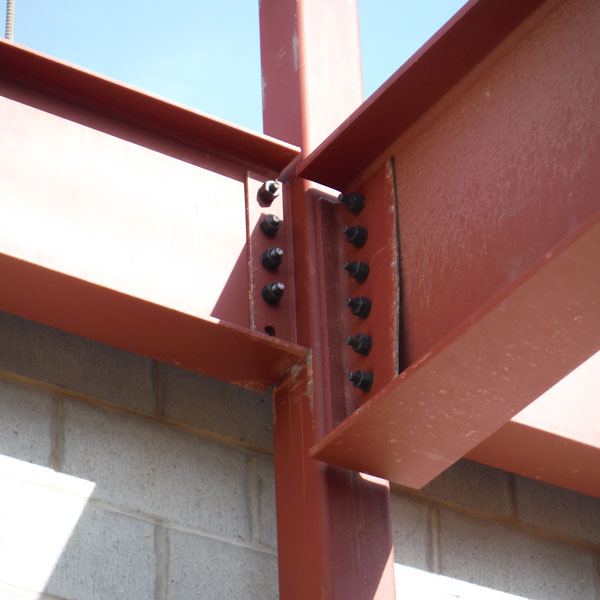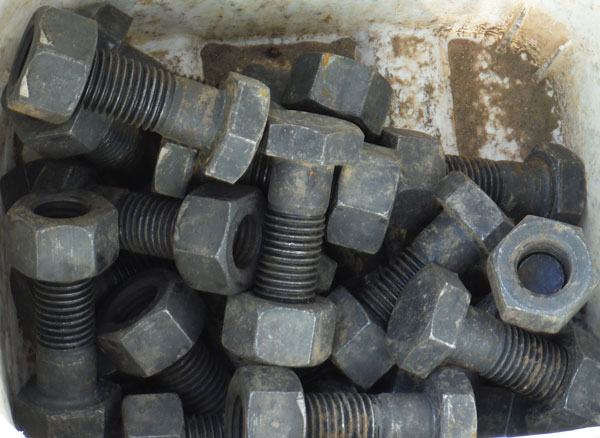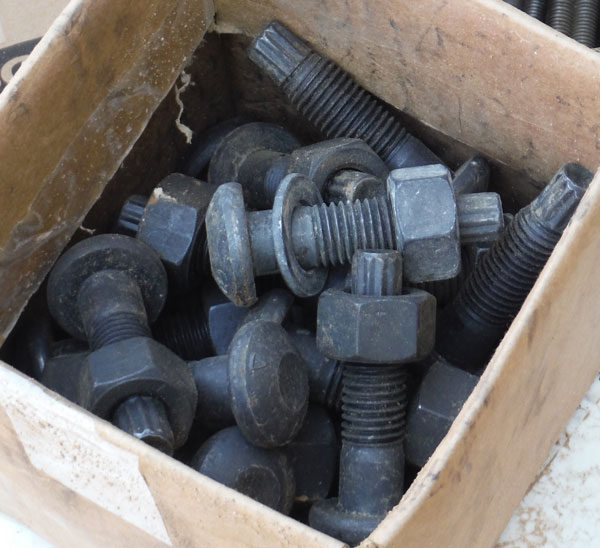
By Gregory Havel
It has been stated many times that the connections in load-bearing structural supports are the weak points in a building. This is especially true if the structural system is old or poorly maintained. These connections are particularly susceptible to failure when exposed to fire, overloaded by building contents, or stressed by natural forces like wind, heavy snow, or earthquakes.
The strength of a bolted joint in structural steel depends on several factors:
- The size of the holes in the structural steel compared to the diameter of the bolts.
- The length of the shank of the bolt. The shank should be long enough so that the shear plane of the joint passes through the shank; but not so long that the shank extends beyond the face of the flange. If the shear plane of the joint passes through the threads on the bolt, the shear strength is reduced by 30-35 percent, due to the reduced cross section of the bolt’s threads when compared to the shank.
- The absence of washers or use of the wrong type of washers in making up the joints.
- The type and strength of bolt and nut used to make the connection.
- The amount of torque (torsional force) applied to the bolt and nut when making up the joint. If there is too little torque, the joint may be too loose to be stable under dead loads and live loads. If there is too much torque, the bolt or the structural steel flanges may be stressed, which could lead to failure of the joint.
- Proper building maintenance, which will prevent leaks from the building envelope, and from pipes, from wetting the connection and accelerating oxidation (rust).

Photo 1 shows bolted joints between steel girders and a column. The bolt flanges were welded to the faces of a square tubular steel column, and the beams are bolted to it. The flange on the left will pass the engineer’s inspection after the fifth bolt is installed; and after the bolts are torqued or tightened. The bolts in this photo are the tension control bolts discussed with Photo 3 below.
The connection on the right will fail the inspection because the flange on the column was bent during shipment or handling. Even if these bolts are properly torqued, the joint will be weak, because these joints are designed to have the column flange in full contact with the web on the girder. Lack of contact makes the joint less rigid.
Sometimes, these structural steel joints use washers, either to allow easier alignment of the flanges because of oversized bolt holes or to reinforce the connections.

Photo 2 shows conventional bolts and nuts used in assembling structural steel. These bolts may be used with or without washers, depending on the design of the bolted joint. They may be installed using a hand wrench and a torque wrench, or one hand wrench and a pneumatic or electric driver with an adjustable clutch set to the required torque for the joint.

Photo 3 shows tension-control bolts with snap-off splines. These bolts are designed to be installed with the head in direct contact with the structural steel. The washer is slipped over the threads, and the nut started by hand. An electric or pneumatic tension control driver is set over the splined end of the bolt and the nut, which grips the bolt and holds it stationary by the spline while it turns the nut down. When the bolt is under proper tension from the torque applied to the nut, the spline snaps off the end of the bolt.
Most buildings with structural steel frames will have this feature concealed, unless they are of Type II (non-combustible) construction. However, if we arrive at the address of an incident and find a building that appears to be neglected and is known to have a structural steel frame, we must assume that the connections and perhaps the structural steel itself are deteriorated and have lost some of their strength. Firefighters should plan for early structural collapse if there is significant fire involvement.
Download this article as a PDF HERE (379 KB).
 Gregory Havel is a member of the Town of Burlington (WI) Fire Department; retired deputy chief and training officer; and a 35-year veteran of the fire service. He is a Wisconsin-certified fire instructor II, fire officer II, and fire inspector; an adjunct instructor in fire service programs at Gateway Technical College; and safety director for Scherrer Construction Co., Inc. Havel has a bachelor’s degree from St. Norbert College; has more than 35 years of experience in facilities management and building construction; and has presented classes at FDIC.
Gregory Havel is a member of the Town of Burlington (WI) Fire Department; retired deputy chief and training officer; and a 35-year veteran of the fire service. He is a Wisconsin-certified fire instructor II, fire officer II, and fire inspector; an adjunct instructor in fire service programs at Gateway Technical College; and safety director for Scherrer Construction Co., Inc. Havel has a bachelor’s degree from St. Norbert College; has more than 35 years of experience in facilities management and building construction; and has presented classes at FDIC.
MORE CONSTRUCTION CONCERNS

